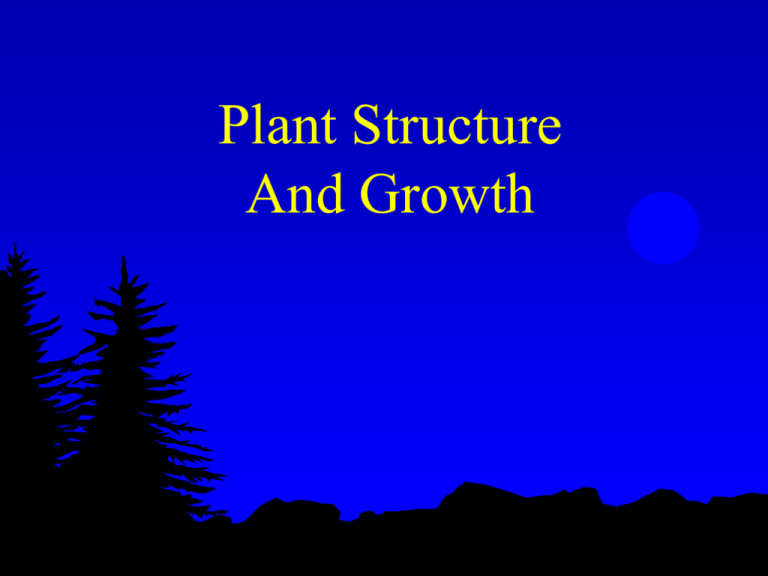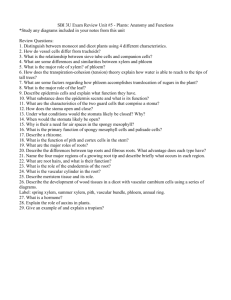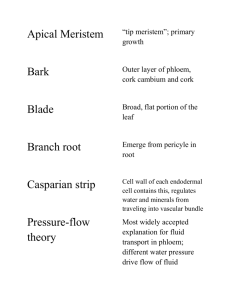Plant Structure And Growth
advertisement

Plant Structure And Growth The Plant Body is Composed of Cells and Tissues Tissue systems made up of tissues made up of cells Plant Tissue Systems Ground Tissue System Vascular Tissue System photosynthesis storage support conduction support Dermal Tissue System Covering Ground Tissue System Parenchyma Tissue Collenchyma Tissue Sclerenchyma Tissue Parenchyma Tissue Made up of Parenchyma Cells Living Cells Primary Walls Functions photosynthesis storage Collenchyma Tissue Made up of Collenchyma Cells Living Cells Primary Walls are thickened Function Support Sclerenchyma Tissue Made up of Sclerenchyma Cells Usually Dead Primary Walls and secondary walls that are thickened (lignin) Fibers or Sclerids Function Support Vascular Tissue System Xylem Tracheids Vessel Elements Phloem Sieve-tube Members Companion Cells Xylem Tracheids dead at maturity pits - water moves through pits from cell to cell Vessel Elements dead at maturity perforations water moves directly from cell to cell Phloem Sieve-tube Members alive at maturity lack nucleus Sieve plates - on end to transport food Companion Cells alive at maturity helps control sievetube member cell Dermal Tissue System Epidermis complex tissue usually transparent secretes cuticle Periderm replaces epidermis in woody plants protection Root System Tap Root Lateral Roots Shoot System Stems Leaves blades petioles Buds Plant Systems Nodes Internodes Terminal (apical) Axillary Plant Growth Meristematic Tissue generates cells for new growth apical meristems lateral meristems Apical Meristems increases length called primary growth Protoderm - gives rise to dermal tissue Ground Meristem - gives rise to ground tissue Procambium - gives rise to vascular tissue Lateral Meristems increases girth called secondary growth Vascular Cambium - produces secondary xylem and phloem Cork Cambium - produces cork The Root System Functions anchor plant absorb minerals, water and nutrients store food Systems taproots - one large root with smaller lateral roots (dicots) fibrous roots - threadlike roots (monocots) Root Structure Four Regions Root Cap - protection Region of Cell Division - new cells Region of Elongation - cells get longer Region of Maturation - cells begin to specialize Root Tissue Protoderm - gives rise to the epidermis Procambium - gives rise to the stele may include pith Ground Meristem Cortex xylem and phloem Monocot vs. Dicot Root Monocot Root (inside to outside) Pith Xylem transport water transport food Pericycle Endodermis Phloem dividing cells Cortex Casparian Strip made of suberin to regulate water and minerals Passage Cells to allow water to pass through storage Epidermis protection Dicot Root (inside to outside) Xylem transport water Endodermis Phloem Pericycle transport food dividing cells Cortex Casparian Strip made of suberin to regulate water and minerals Passage Cells to allow water to pass through storage Epidermis protection Modified Roots Food Storage carrots, sweet potatoes, yams Modified Roots Water Storage manroot, pumpkin family Modified Roots Propagative Roots which produce adventious buds cherries, pears Modified Roots Pnematophores Prop Roots mangroves Modified Roots Aerial Roots orchids, ivies Modified Roots Buttress Roots tropical trees Modified Roots Haustoria dodder Shoot System The Shoot System Made up of Stems, Leaves, Flowers, Fruits Stems - support, conduction, growth Leaves - photosynthesis Flowers - pollination Fruits - seed protection, dispersal Stems (Primary Growth) Protoderm - gives rise to the epidermis Procambium - gives rise to the stele xylem and phloem in vascular bundles dicots - found in ring monocots - scattered throughout includes pith in dicots Ground Meristem Cortex Vascular Bundle Monocot vs. Dicot Stem Monocot Stem (Inside to Outside) Ground Tissue Vascular Bundles Xylem Phloem Fibers Cortex Epidermis Dicot Stem (Inside to Outside) Pith Vascular Bundles Xylem Phloem Fibers Cortex Epidermis Stems (Secondary Growth) Occurs to increase girth (thickness) Vascular Cambium produces secondary xylem and phloem Cork Cambium produces cork and phelloderm together these structures are called periderm Secondary Growth Secondary Growth of a Stem Secondary Growth of a Stem (Inside to Outside) Pith Primary Xylem Secondary Xylem (wood) Vascular Cambium Secondary Phloem Primary Phloem Cortex Phelloderm Cork Cambium Cork Modified Stems Stolons - horizontal stems above the ground Modified Stems Rhizomes - horizontal stems below the ground Modified Stems Tubers - swollen areas of rhizomes Modified Stems Bulbs & Corms vertical shoots under the ground Modified Stems Cladophylls - cactus pads Leaf Structure Simple leaf Compound leaf Double Compound leaf Leaf Structure Leaves Epidermis Stomata - openings on underside of leaf Guard Cells - surround stomata Cuticle - waxy coating excreted by epidermis Mesophyll - middle of leaf Palisade layer - photosynthesis Spongy layer - gas exchange Modified Leaves Needles - reduce water loss Modified Leaves Tendrils - long thin leaves for clinging Modified Leaves Spines - protection Modified Leaves Succulents – water storage






